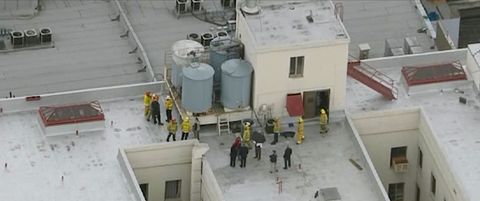In 2013, the last known footage of Elisa Lam came from grainy elevator security camera footage from the Cecil Hotel. The 21-year-old appears frantic and paranoid in the four minutes of footage—pressing multiple buttons, peaking nervously out of the doors, and hiding against the wall of the unmoving elevator from what appears to be an unseen person. The footage has since become infamous, going viral that February after the police first released it to the public, asking for tips in the case of Lam’s disappearance. Scores of internet sleuths jumped on the case of the missing young woman, and theories of paranormal activity, a threatening off-camera figure, and video manipulation quickly began to spread online. It didn’t help that the Canadian tourist, who was last seen on January 31, 2013 during the Los Angeles leg of her West Coast trip, happened to be staying in the notorious Cecil Hotel, a skid row landmark famously shrouded in darkness and crime. The first season of Joe Berlinger’s new Netflix series Crime Scene: The Vanishing at the Cecil Hotel works to demythologize the Cecil, and in doing so, logically work through and demystify the heartbreaking case of Elisa Lam.
This content is imported from YouTube. You may be able to find the same content in another format, or you may be able to find more information, at their web site.
The Cecil Hotel, located in downtown L.A., has a reputation for death. More than a dozen murders and suicides have taken place in and around the Cecil Hotel since its 1927 opening. Elizabeth Short, the Black Dahlia, was said to have been seen at the Cecil days before her murder, and the hotel served as a temporary residence to serial murderers Richard Ramirez and Jack Unterweger at times. Crime Scene largely dispels its reputation as cursed by digging into the problematic socioeconomic history of the area, and the hotel’s part function as low-income housing.
But Lam hadn’t booked a stay at the Cecil. The Vancouver student, who had long been planning a solo trip up the coast of California, opted to stay at the Stay on Main, a downtown budget hostel, for the Los Angeles leg of her trip. The documentary reveals that the Cecil had converted half of its floors to the Stay on Main at the time of Lam’s trip in an attempt to market itself to travelers while simultaneously maintaining its long-term residences on separate floors. While the two properties had different lobbies and entrances, the Cecil Hotel and Stay on Main had shared elevators. Which is, among other reasons, why the elevator video of Lam on the last day she is seen alive was so frightening to so many people online.
Lam was reported missing soon after she failed to check out of her room on February 1, 2013. The docuseries recounts several notable occurrences before she disappeared—the hotel had moved Lam from a shared room to a private one as she had been disturbing her fellow guests. She had been escorted out of a television taping earlier that week because of disruptive behavior, and the hotel’s manager at the time, Amy Price, describes an outburst that Lam had in the hotel lobby, as well. When it was discovered that all of Lam’s belongings—including her I.D., medication, and luggage—were left behind in her hotel room, search parties of police and dogs combed the streets downtown and the halls of the hotel. But they discovered nothing. And so, with no leads, they chose to release the four minutes of jarring elevator footage of Lam to the public on February 14, causing a frenzy online and in the media.
On February 19, 2013, twenty days after Lam was last seen, a hotel staffer was sent up to the roof of the hotel to check on the water tanks after several guest complaints about low pressure and murky water coming out of the taps. It was then when Lam’s body was discovered, floating naked in one of the four large tanks that provided the hotel’s water supply.
The case was closed in June of 2013, and Lam’s cause of death was listed as accidental due to drowning, with bipolar disorder listed as a significant factor. According to the coroner featured in the docuseries, her autopsy revealed that she had not been taking the full dosage of her medication around the time of her death. But the startling behavior of Lam in the elevator and the enduring mystery of how she got up onto the locked roof and into the tank in the first place kept a community of YouTubers, Redditors, and internet sleuths suspicious about the circumstances and hunting for clues. As Crime Scene depicts, inexplicable coincidences and strange oddities in the case—such as the uncanny similarity to the plot of 2005 horror film Dark Water or a government administered tuberculosis test in the area at the time entitled “Lam-Elisa”—kept conspiracy theorists active online for years following Lam’s death.
The documentary works through the case with new interview footage from investigators, web sleuths, and historians, narrated in part by excerpts read from Lam’s Tumblr, which she used as an online diary of sorts, and with graphic recreations of the crime scene. It conveys the degree to which Lam’s tragic case became a paranormal myth in pop culture and online. And although the recreations in Berlinger’s documentary can feel morbid and unsympathetic at times, the through-line of the four-part series is a rational analysis of the socioeconomic circumstances and facts in the case.
The documentary does its best to fact check a number of the most prominent conspiracy theories about the Lam case. For example, one theory claimed that the vocalist of a German metal band killed Lam, however Crime Scene notes that the musician was in Mexico at the time of the death.
Without necessarily presenting new evidence, the documentary largely de-shrouds the mystery surrounding the case by featuring the firsthand testimony of the coroner, investigators, and staff from the Cecil Hotel who had previously not spoken publicly on the matter. By the end of the four episodes, although the mystery of how Lam ended up in the water tank remains, the case is understood to be a tragedy related to a young woman’s mental health, and not a paranormal horror story. Crime Scene works to logically and painstakingly explain away the internet’s largest points of contention with the investigation, and thus lends a sense of closure and finality to the case.
Get 87 Years of Award-Winning Journalism, Every Day
Join Esquire Select
This content is created and maintained by a third party, and imported onto this page to help users provide their email addresses. You may be able to find more information about this and similar content at piano.io








